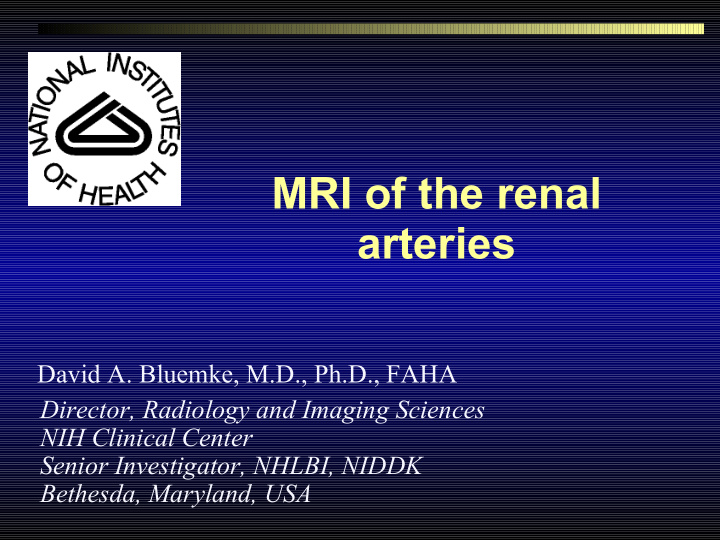



MRI of the renal arteries David A. Bluemke, M.D., Ph.D., FAHA Director, Radiology and Imaging Sciences NIH Clinical Center Senior Investigator, NHLBI, NIDDK Bethesda, Maryland, USA
Disclosures Off-label use: gadolinium enhanced MRI of the blood vessels
Screening for Renal Artery Stenosis: Screening for Renal Artery Stenosis: • low morbidity - no contrast reactions • rapid exam - 15 minutes • low nephrotoxicity compared to iodine agents
3D Gadolinium Renal MRA 3D Gadolinium Renal MRA Study Yr # arteries Sens. Spec. Study Yr # arteries Sens. Spec. Korst et al. ‘00 92 100% 85% De Cobelli ‘00 103 94% 93% Thornton ‘99 87 100% 98% Thornton ‘99 138 88% 92% Hany ‘98 235 93% 90% Bakker ‘98 121 97% 92% De Cobelli ‘97 105 100% 97% Postma ‘97 74 100% 96% Hany ‘97 78 93% 98%
Fluoroscopic MRA trigger Fluoroscopic MRA trigger
Fluoroscopic MRA trigger Fluoroscopic MRA trigger
MRA: Venous phase MRA: Venous phase 3d VIBE, SPGR MRA: 2 nd run
MRA - Aorta MRA - Aorta
• 3D aquisition, 2mm slice thickness • 0.15 mmol/kg gad @ 2ml/sec • Automated timing bolus • 15 sec breath- hold
Renal MRA ?
Renal MRA
Renal MRA: data analysis Renal MRA: data analysis • MIP image • most common “data reduction” method
MRA - reformat MRA - reformat axial axial sagittal sagittal coronal coronal
MRA - reformat
MRA - reformat
3T Renal MRA
3T Renal MRA 3T Renal MRA
MRA - reformat MRA - reformat
Eccentric plaque - MIP pitfall Eccentric plaque - MIP pitfall
Volume Rendering Volume Rendering • retains “3d” information
MR angiogram: accurate/ rapid anatomy MR angiogram: accurate/ rapid anatomy Maximum intensity projection and surface displays Maximum intensity projection and surface displays
Aorto-enteric fistula repair, aneurysm Aorto-enteric fistula repair, aneurysm
Renal MRA: Aneurysm Dynamic MRA (TREAT) Courtesy of Paul Finn, UCLA
MRA - variant anatomy MRA - variant anatomy
MRA - document variant anatomy MRA - document variant anatomy •Early arterial branching
MRA: variant anatomy MRA: variant anatomy
Pitfall Pitfall
Pitfall - susceptibility Pitfall - susceptibility
Pitfall - stent Pitfall
Pitfall: adenoma Pitfall: adenoma
Pitfall: adenoma Pitfall: adenoma
Pitfall: adenoma Pitfall: adenoma
Renal MRA: size matters Renal MRA: size matters • 3D renal size • Is there sufficient renal mass for revascular- ization? •> 1 cm L/R renal size difference
Renal Artery MRA: disadvantages? Renal Artery MRA: disadvantages? • tendency to overestimate (calcification, turbulence) • “unsuccessful” exams (2%-4%) • lower sensitivity for accessory vessels, or intra-renal abnormalities • pacemakers, claustrophobia
Female, long standing hypertension Female, long standing hypertension
“Hypertension” Hypertension” “ Fibromuscular Fibromuscular dysplasia dysplasia
Fibromuscular dysplasia Fibromuscular dysplasia CA CA MRA MRA
Pressure gradient Pressure gradient • By convention, 50% stenosis “physiologically significant” • Experimentally, 70-80% required for a pressure gradient
MRA: Phase contrast MRA: Phase contrast •Improved specificity for stenosis detection • After 3D MRA
Eccentric plaque - MIP pitfall Eccentric plaque - MIP pitfall
Phase contrast
Renal MRA: phase contrast Renal MRA: phase contrast phase contrast Mild stenosis
3T Renal MRA: phase contrast 3T Renal MRA: phase contrast
3T Renal abnormality
Renal transplant Renal transplant Increasing creatinine: • Vascular insufficiency? • Rejection? • Concern for NSF
Renal transplant- Renal transplant- multiple multiple reformations reformations Targeted MIP 3D volume Oblique MIP - early branching
Renal transplant Renal transplant “Normal” anastomotic narrowing
Associations with NSF • Prior gadolinium administration • Severe renal failure, dialysis Stage GFR Description 1 90+ Normal kidney function but urine or other abnormalities point to kidney disease 2 60-89 Mildly reduced kidney function, urine or other abnormalities point to kidney disease 3 30-59 Moderately reduced kidney function
Associations with NSF • Prior gadolinium administration • Severe renal failure, dialysis • Pro-inflammatory events - surgery - infection - trauma
Gadolinium MRA: options in at Gadolinium MRA: options in at risk patients risk patients 1. Noncontrast time of flight MRA 2. 3T MRA: 50% reduction of contrast dose 3. Contrast agent with increased relaxivity (Multihance); allows dose reduction 4. both (2) and (3)
Gadolinium MRA: Time of Gadolinium MRA: Time of Flight Flight
Steady State Free Precession Steady State Free Precession (SSFP) (SSFP) TrueFISP, NATIVE TrueFISP, NATIVE • Blood is imaged as a fluid (long T2* time) using a balanced GRE sequence • ECG and navigator gated
Steady State Free Precession Steady State Free Precession (SSFP): TrueFISP, NATIVE (SSFP): TrueFISP, NATIVE
Steady State Free Precession Steady State Free Precession (SSFP): TrueFISP, NATIVE (SSFP): TrueFISP, NATIVE
Multihance, 3T Multihance, 3T 0.08 mmol/kg 0.08 mmol/kg
Multihance, 3T Multihance, 3T 5 cc 5 cc
Renal MRA (3T): with 3d T1
Acknowledgements • Christine Lorenz, PhD, Steve Shea, Christine Lorenz, PhD, Steve Shea, PhD, Siemens PhD, Siemens • Paul Finn, MD, UCLA Paul Finn, MD, UCLA • Gerhard Laub, PhD, Siemens Gerhard Laub, PhD, Siemens
Thank you Thank you
Recommend
More recommend